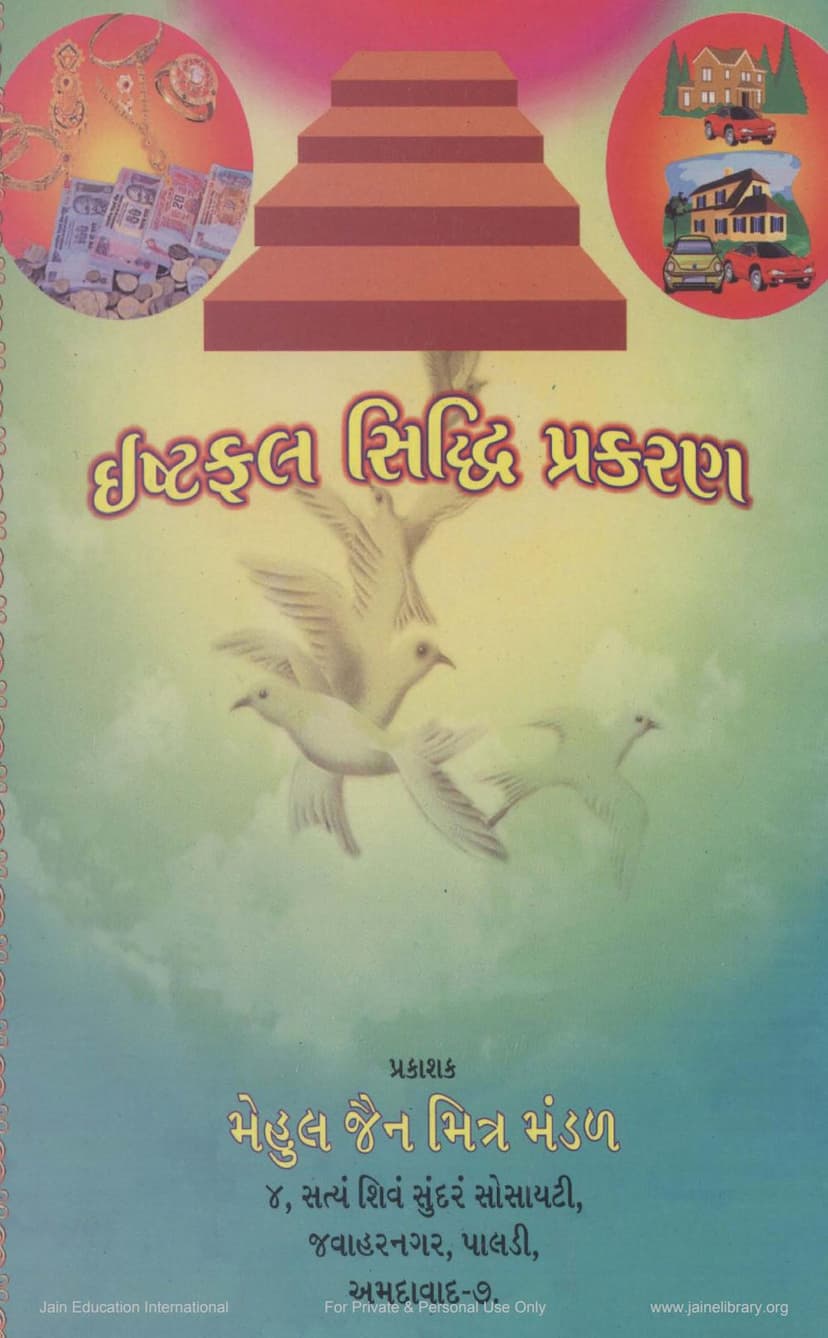Ishtafal Siddhi Prakaran
Added to library: September 1, 2025

Summary
This document is a Gujarati text titled "Ishtafal Siddhi Prakaran" (Chapter on the Attainment of Desired Results), authored by Padmasenvijay. It was published by Mehul Jain Mitra Mandal, Ahmedabad. The catalog link provided is for the Jain Virtual Library.
The core theme of the text, as indicated by its title and the introductory pages, appears to be about "Ishtafal Siddhi", which translates to the "Attainment of Desired Results" or the "Fulfillment of Wishes".
The provided pages (1-157) represent a significant portion, if not the entirety, of the book's content, which is a compilation of scriptural references and explanations.
Here's a breakdown of what the document contains and implies:
- Title and Author: "Ishtafal Siddhi Prakaran" by Padmasenvijay.
- Publisher: Mehul Jain Mitra Mandal, Ahmedabad.
- Purpose: To guide individuals on how to achieve their "desired results" or "wishes" through Jain principles and practices.
- Content Structure: The bulk of the document (from page 8 onwards) consists of a numbered list of "Path No." (પાઠ નં.) followed by "Granth nu Naam" (ગ્રંથનું નામ - Name of the Book) and the relevant "Shlok" (શ્લોક - Verse) or "Page No." (પૃ. નં.). This indicates a compilation of verses and references from various Jain scriptures and commentaries that discuss the concept of "Ishtafal Siddhi".
- Key Themes Explored:
- The Role of Dharma (Religion/Righteousness): Many references highlight that dharma is the primary means to achieve both worldly (artha, kama) and ultimate (moksha) goals. Dharma is often portrayed as the principal pursuit.
- Intentions and Motivations for Practice: The text seems to explore the nuances of why one performs religious practices. It touches upon the idea that even if the initial intention is worldly gain (like health, prosperity, reputation), the practice itself, if aligned with Jain principles, can lead to spiritual progress. This is evident in discussions about "sannidhana" (with an intention) or "nishnidhana" (without intention) vows and practices.
- Moksha as the Ultimate Goal: While worldly benefits are acknowledged as potential outcomes, the ultimate aim of Jain practice is presented as liberation (moksha).
- Importance of Proper Understanding and Intent: The text seems to emphasize the correct understanding of scriptures and the intention behind religious actions. It critiques rigid or one-sided interpretations (ekantavada) and promotes the Jain principle of Anekantavada (multi-faceted reality).
- The Role of Gurus and Teachings: There are references to the guidance of respected acharyas and munis, suggesting the importance of learning from qualified spiritual guides.
- Examples and Illustrations: The compilation draws from a wide range of Jain texts like Naalpanchmi Kahao, Samyaktva Saptatika, Dharmapariksha, Yogabindu, Aakhyanak Manikosh, Dharmaratna Prakaran, Upmiti, Uttaradhyayan Sutra, Pushpamala, Siddhachakra, and many others, providing scriptural authority and illustrative examples.
- Critique of Misinterpretations: The latter part of the document seems to address potential misinterpretations and contrasts different viewpoints, particularly regarding the motivations behind religious practices and the definition of "proper" conduct. It seems to advocate for a balanced approach that acknowledges the reality of worldly needs while keeping the ultimate goal of liberation in sight.
- The concept of "Ishtafal Siddhi" itself: The text clarifies that "Ishtafal Siddhi" in the Jain context refers to the satisfaction of the mind or the attainment of desired objectives, which can lead to mental tranquility, and from that tranquility, engagement in virtuous actions. This is often linked to achieving not just worldly benefits but also ultimately contributing to spiritual progress.
In essence, the book serves as a guide to understanding how Jain principles and practices contribute to fulfilling one's aspirations, both in this life and for the ultimate goal of liberation, emphasizing the importance of correct understanding, righteous conduct (dharma), and the guidance of spiritual masters. It aims to reconcile the pursuit of worldly well-being with the ultimate spiritual objective within the Jain framework.